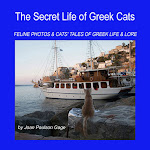Inspired by a current exhibit at the Worcester Art Museum called "Perfectly Strange", which features Diane Arbus's famous photograph of "Identical Twins, Roselle, NJ 1967", I am re-posting an essay I wrote four years ago which has become one of the most popular on "A Rolling Crone". (A list of other essays about historic photos is at right.) It will be one of the chapters in my forthcoming book about antique photographs, tentatively titled "Unlocking the Secrets of Our Earliest Photographs."
Long before she killed herself in 1971 at the age of 48, (pills, slashed wrists, found in the bathtub two days later), the photographer Diane Arbus told a friend she was afraid that she would be remembered simply as “the photographer of freaks.”
Today that’s exactly how she is remembered for her searing, macabre photographs of “deviant and marginal people (dwarfs, giants, transvestites, nudists, circus performers) or else of people whose normality seems ugly or surreal,” as one biographer described her favorite subjects.
But one of her most famous photographs (on the left above) is not of circus freaks or mentally challenged people, but of identical twin girls taken in Roselle, N.J. in 1967.
This eerie photograph of young sisters Cathleen and Colleen Wade has been copied and echoed many times—including in Stanley Kubrick’s film ‘”The Shining” with its twin girl ghosts. In fact there’s a TV commercial on right now (for kitchen appliances) with a pair of similar sinister girls.
A print of Arbus’s twins was sold at auction for $478,000 in 2004 and a couple of months ago I saw another one at the AIPAD photography show in New York that was priced at around $275,000 for a tiny print with Arbus’s notes on the back.
Let’s face it, there’s something intrinsically spooky about twins—especially identical twins—because it’s shocking to see the same individual, the same face, doubled and standing side by side. Maybe that’s why I (and many other collectors) love to find vintage photographic images of twins. They always seem to look like something out of Stephen King.
The 1/6 plate daguerreotype, #1, that I have above next to the Arbus twins, is my favorite dag ever. In my opinion it’s just as good – if not better -- than the Arbus image. The two little girls, who were photographed in the 1840’s or 1850’s, look amazingly like the twins from New Jersey. Compare the faces of the girls on the left in each photo.
The stern young ladies in image #1 are each holding a daguerreotype case inlaid with mother of pearl, and they wear identical gold-tinted pendents and dresses.
(In vintage photos it’s very common for siblings—not just twins -- to be dressed alike, because Mom would buy a long length of fabric and then the dressmaker would come around to stitch up clothing for all the kids from the same bolt of cloth.)
These are some of my prize twin images—all of them spooky. In the early days of photography, people were not only intimidated by this modern invention, they were warned not to move—certainly not to smile—because it would blur the image. Children were often strapped into a chair with their heads in a brace. No wonder they often look terrified!
(Click on the photos to make them bigger.)

Images 1 , 2, 3, 4 and 5 above are all daguerreotypes—the very earliest photographic process. Don’t you love the dour sisters in the checkerboard dresses in #3 (not a flattering pattern!) and next to them the long-faced girls in plaid. The sisters in image 5 I suspect, because of their somber clothing and jewelry, may be in mourning.

The girls holding books in image 6 are not identical, but the men in image 7 are mirror images of each other. I love how their top-knots curl in opposite directions. (Six and 7 are ambrotypes—negative images on glass—popular from 1854 to 1865.) People were always worried about how to pose their hands in these early days, and the photographer would arrange hands awkwardly like the ones you see here.

The two women in image 9 may not be twins, or even sisters, but I cherish them because they are feminists from the mid-1800’s! Written in the case behind their daguerreotype is this: “Mary, you and my self are still left single/ while others are double and full of trouble. Your KPL”
Photos 11 to 14 are tintypes, which became popular during the Civil War and continued into the 1900’s. The girls in 11 and the boys in 12 have high button shoes, and the ladies in #14, in ruffled skirts, are posed in a photographer’s studio. Check out the bathing beauties in #13, on a holiday at the seashore (but posed in front of a painted canvas background.)

The toddlers in # 15 are boy/girl twins. (Boys wore dresses until after age 5.) Their mother has written on the back of the cabinet card “Twins. Left, Louise Bertha Inez Forte. Right Louis Bertrand Forte. Born June 13th, 1893 at 2 p.m. in West Newton. Louis was born 5 minutes after Louise.”
An equally helpful relative noted the names of the young flappers in image #16, who look very chic in their cloche hats, as “Alice Antoinette Howland and Harriet Alma Howland, 1926.” Their relaxed pose in their fur-collared coats makes for a beautiful portrait, but none of the twins can compare to my ghostly, sour-faced girls from 170 years ago in image #1.































